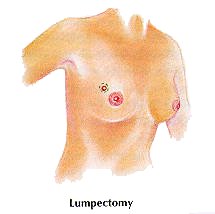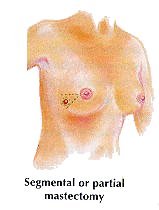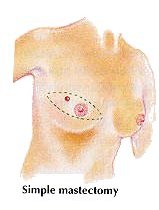Lumpectomy
Lumpectomy and Radiation Therapy
Mastectomy
Mastectomy with Breast Reconstruction Surgery
Treating Breast Tumors
A key component of breast cancer treatment is surgery. It may be used alone or in combination with other treatments, such as chemotherapy, hormone therapy, targeted therapy and radiation therapy.
Breast cancer surgery includes the following procedure options:
- A lumpectomy to remove a portion of the breast tissue, including the cancer and some normal tissue around it (This is also referred to as breast conservation therapy: BCT.)
- Lymph nodes removal for biopsy
- A mastectomy to remove all or part of the breast
- Preventative surgery, an option for women and men with a very high risk of breast cancer
- Breast reconstruction after a mastectomy
The type of breast cancer operation depends on the size and stage of the cancer, as well as other treatment options and the patient’s personal goals and preferences.
Most women with breast cancer in stages I, II or III are treated with surgery, and this is often followed by radiation therapy. Many women also get some form of drug therapy like chemotherapy, or oral medication, such as hormone therapy. In general, the more the breast cancer has reached a later stage or spread (past the original tumor), the more treatment the patient will need.
Although the patient makes the final decision about the extent of any breast surgery they consent to undergo, the decision should be based on their physician’s and surgeon's judgement, and on complete information about the likely benefits and possible consequences of each alternative.
Lumpectomy is surgery to remove early-stage breast cancer or other abnormal tissue from the
breast. During a lumpectomy procedure, the surgeon removes the cancer or other abnormal tissue and
1 to 2 centimeters (cm) of the healthy tissue that surrounds it. The surgeon also removes one or more
lymph nodes from under the patient’s arm. This breast-sparing procedure usually keeps the breast looking
much like it did before surgery. A lumpectomy can also be used to rule out a cancer diagnosis.
Lumpectomy and Radiation Therapy
 Lumpectomy, followed by radiation therapy, is the treatment of choice now in those women with early-stage breast cancer. The main goal of this treatment is to keep cancer from coming back in the same breast. Radiation therapy usually begins about two to four weeks after lymph-node surgery and continues for 3 to 5 weeks, based on each individual's care plan. When the treatments are completed, an extra "boost" of radiation is usually given to the area where the tumor was located.
Lumpectomy, followed by radiation therapy, is the treatment of choice now in those women with early-stage breast cancer. The main goal of this treatment is to keep cancer from coming back in the same breast. Radiation therapy usually begins about two to four weeks after lymph-node surgery and continues for 3 to 5 weeks, based on each individual's care plan. When the treatments are completed, an extra "boost" of radiation is usually given to the area where the tumor was located.
- According to a 2014 study in the Journal of the American Medical Association, five years after diagnosis, disease-specific survival rates were 97% for women who got lumpectomy plus radiation; 94% for women who got mastectomy alone and 90% for women who got mastectomy plus radiation.
- Long-term survival for stage I-II patients treated with breast cancer surgery followed with radiation to the breast is the same as that for treatment with mastectomy alone, according to the American Cancer Society’s 2019-2020 figures.
Mastectomy
Most mastectomies are generally one of several types. Each patient, in consultation with her surgeon and on complete information about the likely benefits and possible consequences of each alternative, decides which one is best for her.
 Segmental or partial mastectomy: Segmental or partial mastectomy (sometimes called quadrantectomy) is the resection of the tumor and some of the normal breast tissue surrounding the primary lesion. In almost all cases, radiation therapy follows surgery.
Segmental or partial mastectomy: Segmental or partial mastectomy (sometimes called quadrantectomy) is the resection of the tumor and some of the normal breast tissue surrounding the primary lesion. In almost all cases, radiation therapy follows surgery.- Simple (or total) mastectomy: The surgeon removes only the entire effected breast, leaving intact both the lymph nodes and pectoral muscles. Although opinions differ regarding the removal of lymph nodes from the armpit, many feel the simple mastectomy may be the best treatment for elderly, debilitated patients.
- Skin-sparing mastectomy:
 Most of the skin over the breast is left intact. Only the breast tissue, nipple and areola are removed. The amount of breast tissue removed is the same as with a simple mastectomy. Implants or tissue from other parts of the body can be used during the surgery to reconstruct the breast. Information on breast reconstruction.
Most of the skin over the breast is left intact. Only the breast tissue, nipple and areola are removed. The amount of breast tissue removed is the same as with a simple mastectomy. Implants or tissue from other parts of the body can be used during the surgery to reconstruct the breast. Information on breast reconstruction. - Nipple-sparing mastectomy: Breast tissue is removed, but the breast skin and nipple are left in place. This can be followed by breast reconstruction. The surgeon often removes the breast tissue beneath the nipple (and areola) during the procedure to check for cancer cells. If cancer is found in this tissue, the nipple must be removed.
- Modified radical mastectomy: This combines a simple mastectomy with the removal of the lymph nodes under the arm. leaving intact the chest muscles (called an axillary lymph node dissection). Retaining the pectoral muscles reduces disfigurement and may facilitate later reconstructive surgery.
- Radical mastectomy: The surgeon removes the entire breast, axillary (underarm) lymph nodes, and the pectoral (chest wall) muscles under the breast. This extensive surgery is rarely done now because less extensive surgery (such as the modified radical mastectomy) has been found to be just as effective and with fewer side effects. This operation may still be done for large tumors that are growing into the pectoral muscles.
- Double or bi-lateral mastectomy: Both breasts are removed. This type of surgery is done as a risk-reducing surgery for patients at very high risk for getting breast cancer, such as those with a BRCA gene mutation. Most of these mastectomies are simple mastectomies, but some may be nipple-sparing. There are other circumstances where a double mastectomy might be done as part of a women's breast cancer treatment plan. This is done after careful consideration and discussion between the patient and their cancer care team.
Mastectomy with Breast Reconstruction Surgery
Breast reconstruction can be done at the same time as the mastectomy or any time after. This type of surgery is done by a plastic surgeon with experience in reconstruction surgery. The surgeon uses an implant or tissue from another part of the patient’s body to create a breast-like shape that replaces the breast that was removed. The surgeon may also make the form of a nipple and add a tattoo that looks like the areola.
To learn more about Breast Reconstruction Surgery, click here.
To make an appointment with a plastic and reconstructive surgeon, call (631) 444-8210.

